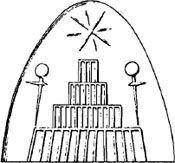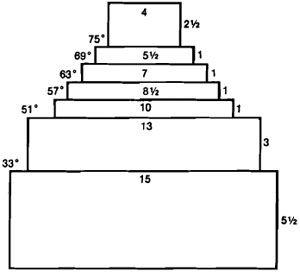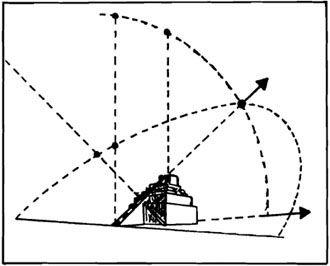The 12th Planet (49 page)
Authors: Zecharia Sitchin
Tags: #Non-Fiction, #Gnostic Dementia, #Fringe Science, #Retail, #Archaeology, #Ancient Aliens, #History

Fig. 135

Fig. 136
Marduk claimed that the ziggurat and temple compound at Babylon (the E.SAG.IL) had been built under his own instructions, also in accordance with the "writing of Upper Heaven." A tablet (known as the Smith Tablet, after its decipherer), analyzed by Andre Parrot
(Ziggurats et Tour de Babel)
established that the seven-stage ziggurat was a perfect square, with the first stage or base having sides of 15
gar
each. Each successive stage was smaller in area and in height, except the last stage (the god's residence), which was of a greater height. The total height, however, was again equal to 15
gar,
so that the complete structure was not only a perfect square but a perfect cube as well.
The
gar
employed in these measurements was equivalent to 12 short cubits—approximately 6 meters, or 20 feet. Two scholars, H. G. Wood and L. C. Stecchini, have shown that the Sumerian sexagesimal base, the number 60, determined all the primary measurements of Mesopotamian ziggurats. Thus each side measured 3 by 60 cubits at its base, and the total was 60
gar.
(Fig. 137)
What factor determined the height of each stage? Stecchini discovered that if he multiplied the height of the first stage (5.5
gar)
by double cubits, the result was 33, or the approximate latitude of Babylon (32.5 degrees North). Similarly calculated, the second stage raised the angle of observation to 51 degrees, and each of the succeeding four stages raised it by another 6 degrees. The seventh stage thus stood atop a platform raised to 75 degrees above the horizon at Babylon's geographic latitude. This final stage added 15 degrees—letting the observer look straight up, at a 90-degree angle. Stecchini concluded that each stage acted like a stage of an astronomical observatory, with a predetermined elevation relative to the arc of the sky.
There may, of course, have been more "hidden" considerations in these measurements. While the elevation of 33 degrees was not too accurate for Babylon, it was precise for Sippar. Was there a relationship between the 6-degree elevation at each of four stages and the 6
-beru
distances between the Cities of the Gods? Were the seven stages somehow related to the location of the first seven settlements, or to Earth's position as the seventh planet?
G. Martiny
(Astronomisches zur babylonischen Turm)
showed how these features of the ziggurat suited it for celestial observations, and that the topmost stage of the Esagila was oriented toward the planet Shupa (which we have identified as Pluto) and the constellation Aries. (Fig. 138)
But were the ziggurats raised solely to observe the stars and planets, or were they also meant to serve the spacecraft of the Nefilim? All the ziggurats were oriented so that their corners pointed exactly north, south, east, and west. As a result, their sides ran precisely at 45-degree angles to the four cardinal directions. This meant that a space shuttle coming in for a landing could follow certain sides of the ziggurat exactly along the flight path—and reach Sippar without difficulty!
The Akkadian/Babylonian name for these structures,
zukiratu,
connoted "tube of divine spirit." The Sumerians called the ziggurats ESH; the term denoted "supreme" or "most high"—as indeed these structures were. It could also denote a numerical entity relating to the "measuring" aspect of the ziggurats. And it also meant "a heat source" ("fire" in Akkadian and Hebrew).
Even scholars who have approached the subject without our "space" interpretation could not escape the conclusion that the ziggurats had some purpose other than to make the god's abode a "high-rise" building. Samuel N. Kramer summed up the scholastic consensus: "The ziggurat, the stagetower, which became the hallmark of Mesopotamian temple architecture ... was intended to serve as a connecting link, both real and symbolic, between the gods in heaven and the mortals on earth,"

Fig. 137

Fig. 138
We have shown, however, that the true function of these structures was to connect the gods in Heaven with the gods—not the mortals—on Earth.
11
•
MUTINY OF THE ANUNNAKI
After Enlil arrived on Earth in person, "Earth Command" was transferred out of Enki's hands. It was probably at this point that Enki's epithet or name was changed to E.A ("lord waters") rather than "lord earth."
The Sumerian texts explain that at that early stage in the arrival of the gods on Earth, a separation of powers was agreed upon: Anu was to stay in the heavens and rule over the Twelfth Planet; Enlil was to command the lands; and Enki was put in charge of the AB.ZU
(apsu
in Akkadian). Guided by the "watery" meaning of the name E.A, scholars have translated AB.ZU as "watery deep," assuming that, as in Greek mythology, Enlil represented the thundering Zeus, and Ea was the prototype of Poseidon, God of the Oceans.
In other instances, Enlil's domain was referred to as the Upper World, and Ea's as the Lower World; again, the scholars assumed that the terms meant that Enlil controlled Earth's atmosphere while Ea was ruler of the "subterranean waters"—the Greeklike Hades the Mesopotamians supposedly believed in. Our own term
abyss
(which derives from
apsu)
denotes deep, dark, dangerous waters in which one can sink and disappear. Thus, as scholars came upon Mesopotamian texts describing this Lower World, they translated it as
Unterwelt
("underworld") or
Totenwelt
("world of the dead"). Only in recent years have the Sumerologists mitigated the ominous connotation somewhat by using the term
netherworld
in translation.
The Mesopotamian texts most responsible for this misinterpretation were a series of liturgies lamenting the disappearance of Dumuzi, who is better known from biblical and Canaanite texts as the god Tammuz. It was with him that Inanna/Ishtar had her most celebrated love affair; and when he disappeared, she went to the Lower World to seek him.
The massive
Tammuz-Liturgen und Verwandtes
by P. Maurus Witzel, a masterwork on the Sumerian and Akkadian "Tammuz texts," only helped perpetuate the misconception. The epic tales of Ishtar's search were taken to mean a journey "to the realm of the dead, and her eventual return to the land of the living."
The Sumerian and Akkadian texts describing the descent of Inanna/Ishtar to the Lower World inform us that the goddess decided to visit her sister Ereshkigal, mistress of the place. Ishtar went there neither dead nor against her will—she went alive and uninvited, forcing her way in by threatening the gatekeeper:
If thou openest not the gate so that I cannot enter,
I will smash the door, I will shorter the bolt,
I will smash the doorpost, I will move the doors.
One by one, the seven gates leading to the abode of Ereshkigal were opened to Ishtar; when she finally made it, and Ereshkigal saw her, she literally blew her top (the Akkadian text says, "burst at her presence"). The Sumerian text, vague about the purpose of the trip or the cause of EreshkigaI's anger, reveals that Inanna expected such a reception. She took pains to notify the other principal deities of her journey in advance, and made sure that they would take steps to rescue her in case she was imprisoned in the "Great Below."
The spouse of Ereshkigal—and Lord of the Lower World—was Nergal. The manner in which he arrived in the Great Below and became its lord not only illuminates the human nature of the "gods" but also depicts the Lower World as anything but a "world of the dead."
The tale, found in several versions, begins with a banquet at which the guests of honor were Anu, Enlil, and Ea. The banquet was held "in the heavens," but not at Anu's abode on the Twelfth Planet. Perhaps it took place aboard an orbiting spacecraft, for when Ereshkigal could not ascend to join them, the gods sent her a messenger who "descended the long staircase of the heavens, reached the gate of Ereshkigal." Having received the invitation, Ereshkigal instructed her counselor, Namtar:
"Ascend, Namtar, the long staircase of the heavens;
Remove the dish from the table, take my share;
Whatever Anti gives to thee, bring it all to me."
When Namtar entered the banquet hall, all the gods except "a bald god, seated in the back," rose to greet him. Namtar reported the incident to Ereshkigal when he returned to the Lower World. She and all the lesser gods of her domain were insulted. She demanded that the offending god be sent to her for punishment.
The offender, however, was Nergal, a son of the great Ea. After a severe reprimand by his father, Nergal was instructed to make the trip alone, armed only with lots of fatherly advice on how to behave. When Nergal arrived at the gate, he was recognized by Namtar as the offending god and led in to "Ereshkigal's wide courtyard," where he was put to several tests.
Sooner or later, Ereshkigal went to take her daily bath.
. . . she revealed her body.
What is normal for man and woman,
he ... in his heart ....
they embraced,
passionately they got into bed.
For seven days and nights they made love. In the Upper World, an alarm had gone out for the missing NergaI. "Release me," he said to EreshkigaI. "I will go, and I will come back," he promised. But no sooner had he left than Namtar went to Ereshkigal and accused Nergal of having no intention of coming back. Once more Namtar was sent up to Anu. Ereshkigal's message was clear:
I, thy daughter, was young;
I have not known the play of maidens....
That god whom you didst send,
and who had intercourse with me—
Send him to me, that he may be my husband,
That he might lodge with me.
With married life perhaps not yet on his mind, Nergal organized a military expedition and stormed the gates of Ereshkigal, intending to "cut off her head." But Ereshkigal pleaded:
"Be thou my husband and I will be thy wife.
I will let thee hold dominion
over the wide Lower Land.
I will place the Tablet of Wisdom in thy hand.
Thou shalt be Master, I will be Mistress."
And then came the happy ending:
When Nergal heard her words,
He took hold of her hand and kissed her,
Wiping away her tears:
"What thou hast wished for me
since months past-so be it now!"
The events recounted do not suggest a Land of the Dead. Quite the contrary: It was a place the gods could enter and leave, a place of lovemaking, a place important enough to be entrusted to a granddaughter of Enlil and a son of Enki. Recognizing that the facts do not support the earlier notion of a dismal region, W. F. Albright
(Mesopotamian Elements in Canaanite Eschatology)
suggested that Dumuzi's abode in the Lower World was "a bright and fruitful home in the subterranean paradise called 'the mouth of the rivers' which was closely associated with the home of Ea in the Apsu."
The place was far and difficult to reach, to be sure, and a somewhat "restricted area," but hardly a "place of no return." Like Inanna, other leading deities were reported going to, and returning from, this Lower World. Enlil was banished to the Abzu for a while, after he had raped Ninlil. And Ea was a virtual commuter between Eridu in Sumer and the Abzu, bringing to the Abzu "the craftsmanship of Eridu" and establishing in it "a lofty shrine" for himself.
Far from being a dark and desolate place, it was described as a bright place with flowing waters.
A rich land, beloved of Enki;
Bursting with riches, perfect in fullness ...
Whose mighty river rushes across the land.
We have seen the many depictions of Ea as the God of Flowing Waters. It is evident from Sumerian sources that such flowing waters indeed existed—not in Sumer and its flatlands, but in the Great Below. W. F. Albright drew attention to a text dealing with the Lower World as the Land of UT.TU—"in the west" of Sumer. It speaks of a journey of Enki to the Apsu:
To thee, Apsu, pure land,
Where great waters rapidly flow,
To the Abode of Flowing Waters
The Lord betakes himself....
The Abode of Flowing Waters
Enki in the pure waters established;
In the midst of the Apsu,
A great sanctuary he established.
By all accounts, the place lay beyond a sea. A lament for "the pure son," the young Dumuzi, reports that he was carried off to the Lower World in a ship. A "Lamentation over the Destruction of Sumer" describes how Inanna managed to sneak aboard a waiting ship. "From her possessions she sailed forth. She descends to the Lower World."
A long text, little understood because no intact version has been found, deals with some major dispute between Ira (Nergal's title as Lord of the Lower World) and his brother Marduk. In the course of the dispute, Nergal left his domain and confronted Marduk in Babylon; Marduk, on the other hand, threatened: "To the Apsu will I descend, the Anunnaki to supervise... my raging weapons against them I will raise." To reach the Apsu, he left the Land of Mesopotamia and traveled over "waters that rose up." His destination was Arali in the "basement" of Earth, and the texts provide a precise clue as to where this "basement" was:
In the distant sea,
100 beru
of water [away] ...
The ground of
Arali
[is] ...
It is where the Blue Stones cause ill,
Where the craftsman of Anu
the Silver Axe carries, which shines as the day.
The
beru,
both a land-measuring and a time-reckoning unit, was probably used in the latter capacity when travel over water was involved. As such it was a double hour, so that one hundred
beru
meant two hundred hours of sailing. We have no way of determining the assumed or average sailing speed employed in these ancient distance reckonings. But there is no doubt that a truly distant land was reached after a sea voyage of over two or three thousand miles.
The texts indicate that Arali was situated west and south of Sumer. A ship traveling two to three thousand miles in a southwesterly direction from the Persian Gulf could have only one destination: the shares of southern Africa.
Only such a conclusion can explain the terms Lower World, as meaning the southern hemisphere, where the Land of Arali was, as contrasted with the Upper World, or northern hemisphere, where Sumer was. Such a division of Earth's hemispheres between Enlil (northern) and Ea (southern) paralleled the designation of the northern skies as the Way of Enlil and the southern skies as the Way of Ea.
The ability of the Nefilim to undertake interplanetary travel, orbit Earth, and land on it should obviate the question whether they could possibly have known of southern Africa, besides Mesopotamia. Many cylinder seals, depicting animals peculiar to the area (such as the zebra or ostrich), jungle scenes, or rulers wearing leopard skins in the African tradition, attest to an "African connection."
What interest did the Nefilim have in this part of Africa, diverting to it the scientific genius of Ea and granting to the important gods in charge of the land a unique "Tablet of Wisdom"?
The Sumerian term AB.ZU, which scholars have accepted to mean "watery deep," requires a fresh and critical analysis. Literally, the term meant "primeval deep source"—not necessarily of waters. According to Sumerian grammatical rules, either of two syllables of any term could precede the other without changing the word's meaning, with the result that AB.ZU and ZU.AB meant the same thing. The latter spelling of the Sumerian term enables identification of its parallel in the Semitic languages, for
za-ab
has always meant and still means "precious metal," specifically "gold," in Hebrew and its sister languages.
